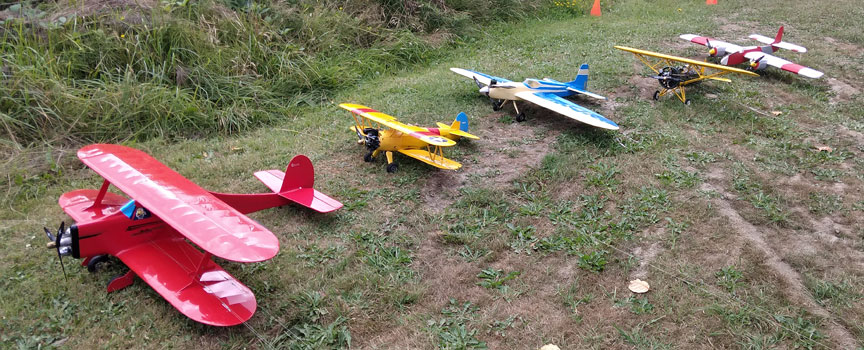Scale Matters
The Snohomish Radio Aero Club in Snohomish, Wash., has a control-line circle; here are some members' planes lined up and ready for flying. Descriptions of the planes are in the text below. All photos by Orin Humphries.
North Sound Sport Control-line — and the mysteries of propellers
By Orin Humphries
December 2021
This is about using different props on our sport models which gave us amazing performance increases. Pro Stunters already know about prop pitches that we will see below, but there are oceans of sport modelers who don’t. This piece is to them.
We have spent our lives using the hobby-wide recommended 10x6 props on C-Class engines and “Dx6” props on other engine sizes. They have served us well enough on our Ringmasters, Noblers and the like. Six or more years ago I asked a Stunter at the Roseburg Regionals what props he used. He replied that he used a 10x4. That was wild for me. I was making a central mistake of assuming we would be turning to the same rpm as with a 6-pitch prop. Wrong. I found no source of 4-pitch props for several years afterwards. A couple of years ago the variety of prop pitches and diameters expanded greatly, especially in the Master Airscrew line. I know some people feel there are more efficient prop brands out there for their competitive purposes, but sport flyers please hear me out.
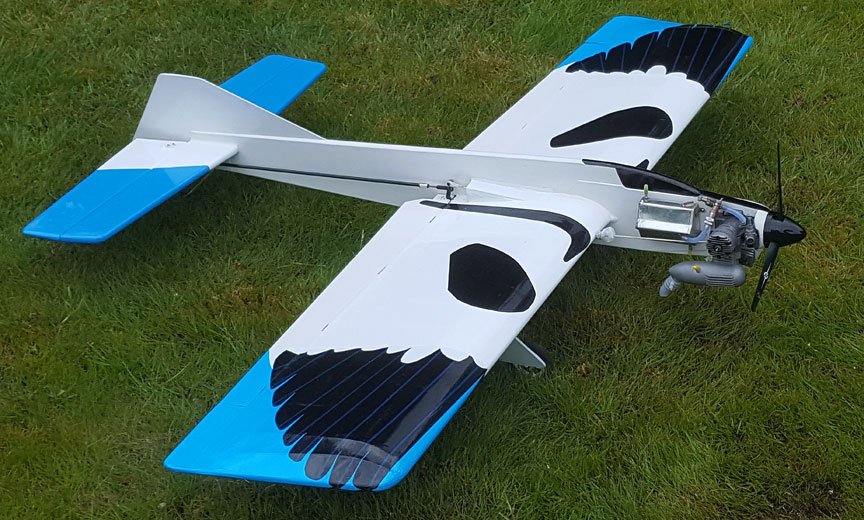
Orin Humphries Pathfinder, decorated as a bird.
This is my Brodak Pathfinder made up as a bird, the Eurasian Avocet. It has an OS .40FP on it. These kits recommend .40-.46 engines. I want to eventually move mine out to 65 feet or more, so I bought a .46LA on eBay and set it aside. The model flew on 60-foot lines just below expectations, power-wise. It was weak on top. That was with a two-blade prop, 2-11x6. I switched to a 10x4 and saw the RPM jump from about 10,300 up to 12,500 and wanting to go higher! It flew like a totally different airplane. The increase in power and line pull blew me away. The engine was operating higher up on the power curve. I next tried a MA 3-10x7 and the RPM was lower, yielding less power and pull. I switched to a MA 3-10x5 prop and got my higher performance back. This prop turned 11,600rpm.

Jeral Godfrey's Smoothie at left and Orin's ARF Nobler on the right.
This is Jeral Godfrey’s new build of an old Smoothie kit. It has an old K&B green head .35 with a Tatone muffler. Using a 2-10x4 prop on it gave it sufficient overhead pull which it hadn’t had. Next to it is my Top Flite ARF Nobler with an OS .40FP. Both of my Noblers use the MA 3-10x5 props and have flown well on 65-foot lines.
About the ARF Nobler kits, they are manufactured in Asia and are lacking. The control hardware looks like American made, but there are problems. The arms of the flap and elevator horns are not co-planar and need to be bent. The kit amazingly does not come with a pushrod guide and the first loops I did with one were nearly the size of a hamlet. Being a modeler of integrity I will not assert that the loops were the size of a village. ( Sorry…) I got into it and replaced the wire pushrod with a carbon fiber one. Problem cured. I am surprised that Top Flite would market a kit without an elevator pushrod guide.
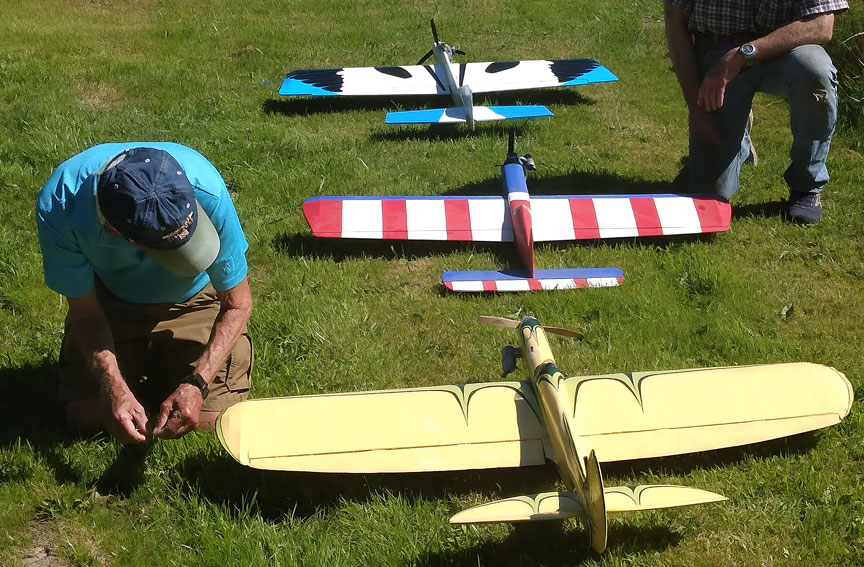
Front to back: Jeral Godfrey's Detroit Stunter, Jim Zevely's All American and Orin's Pathfinder.
In the foreground is Jeral’s vintage Detroit Stunter from plans he found online. The middle ship is Jim Zevely’s vintage All American with flag livery. At the top is my Avocet-decorated Pathfinder. Jim has about 47 models built. Note the three-blade on my bird.
I would like to put in some feedback I got from Bob Gore of Kennewick, Wash., on using lower pitches in our props. We met via my article on tanks and got into lowering choices of prop pitch vs. performance. He has a Pathfinder with a .46 and was thinking of up-engining based upon his plane having weak line pull up on top. I started a conversation with him about lowering prop pitches. He had been using a 2-11x6 and agreed to try something lower. He gingerly switched to a 2-11x5 and his results are below.
“Hi Orin
Once again I have to admit that you are right. I ran down to the park and flew my Pathfinder with a 5 pitch rather than a 6 pitch X 11 inch prop. When I started the motor and leaving the needle valve the way I've been using it, the motor jumped up to around 11,000 rpm I opened the valve enough to slow the motor to about 10,800 rpm( I had been running the motor at 9,800 with a 6 pitch prop ) and I flew the plane. As near as I could tell the plane was flying about the same speed as it had been with the 6 pitch , don't know if that makes any sense as I was just counting seconds in my head as I flew the circle. Once the plane reached its speed the motor sounded like it picked another 200 rpm so maybe 11,000 rpm total. Bottom line is that it's a new airplane ! The plane didn't seem to slow down in any of the maneuvers, like vertical 8s , horizontal 8s, hourglass and overhead 8s. I could stay up on the overhead 8 as long as I wanted and I had solid line tension all the time. And thanks to the new fuel tank configuration the motor never sputtered until the clock told me it was time to be careful. Oh and by the way I checked when I got home to see how much fuel was left in the tank and there was nothing in it, wow is that cool or what ? THINGS ARE LOOKING UP ORIN thanks to you ! !
I only flew once as the wind was doing funny stuff and trees around me so I decided to get more serious another day. I didn't bother with the Twister today I did add another 1/4 ounce to the tail and reset the leadouts so we'll see what happens next time I fly the Twister. Right now I'm so excited about the Pathfinder that I'm not very worried about the Twister. I do wish I had been in contact with you a few years sooner. I might not have wrecked so many airplanes :-) and I'd be further along in my efforts to learn the pattern but when I look back at it, it's all been fun just the same.
Bye for now............ Bob Gore”
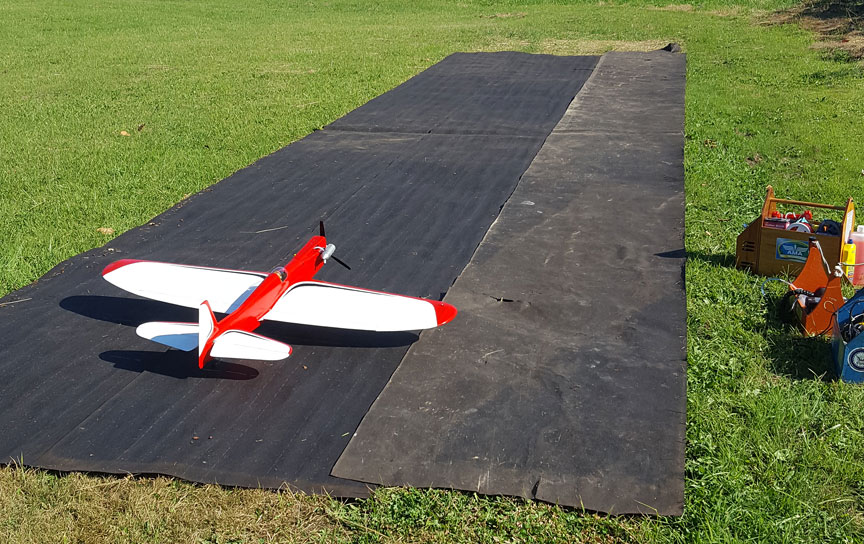
Tarpaper runway used at the SRAC CL circle.
This is our tarpaper runway at the Snohomish Radio Aero Club, SRAC, Field in Snohomish, WA. Do you know of another RC Field that has a CL circle? We first tried the lighter grade tarpaper but it did not hold up well. This is our heavy weight tarpaper strip and it lasts longer. I would like to be able to put down a runway made of artificial turf remnants, but the wallet won’t handle that right now.
This is Jeral’s kit-built Thunderbird with and OS .40FP and a MA 3-10x5 prop. The kit was from the second manufacturer.
The photo at the top of the article shows some more action up at the SRAC Field. On the left is my venerable Beech Staggerwing. It has an OS .40FSR that has flown with a 6-pitch prop all of its life. The plane never saw the top of 45° up with that pitch of any make and the pull was weak up there. With a MA 3-10x5 prop I flew it on that day to 80° in a wingover and it had all the power it needed and plenty of line pull. It flew like a different airplane. Behind it is my N2S Stearman from a Sterling kit from eBay. In the middle is Jeral’s Smoothie again. Next to last is Jeral’s first foray into Scale, a parasol Boeing XF5B-1. On the right is Jim’s new F7F Tigercat. The Tigercat will do simple stunt maneuvers.

Jim Zevely with two of his planes.
Jim lives in Anacortes, Wash., where there are two grass fields available, much of the time, but no other CL flyers. He comes down to Snohomish to fly with others like him, us. On our right is his scratch built F7F Tigercat. Behind it is his enlarged 60” span Ringmaster with gold and maroon iron-on covering he got as a closeout at Sig long ago.
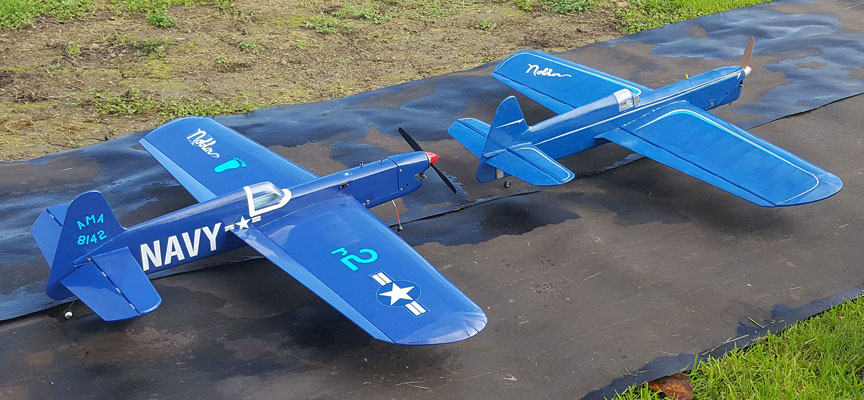
At left, Orin's ARF Nobler and at right, Jeral Godfrey's Nobler.
Finally, some of our Nobler stables, my No. 2 Nobler is at the rear and it is an ARF kit. The bird in front is Jeral's. He lives in Mukilteo, Wash. His Nobler is old-kit built. I wanted three stunters in my stable for redundancy. I intend to push the envelope of my rudimentary Stunt skill and I don’t want to be down because my only stunter is broken. So now I have two Noblers and one Pathfinder. My friend, Ben Olson from the museum, our mechanic, lives in Gig Harbor, Wash., and has started coming up to fly with us at the SRAC Field. Jeral and I will reciprocate and fly with them at their home fields soon. Ben has started building an ARF kit Nobler.
Conclusion: The performance increase is so surprising that sport flyers have to ask of it means anything if some other brand than Master Airscrew is “more efficient”. De-pitch your props and tighten your needle valves, folks.
Flying Lines home page
Back to Scale Matters column main page
Back to Scale main page
This page was upated July 27, 2022

